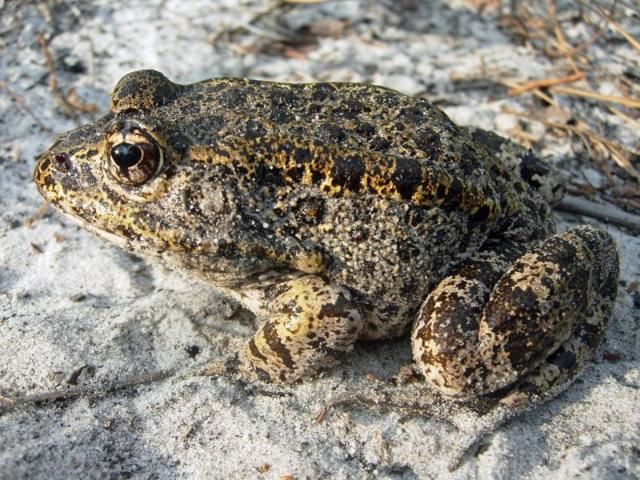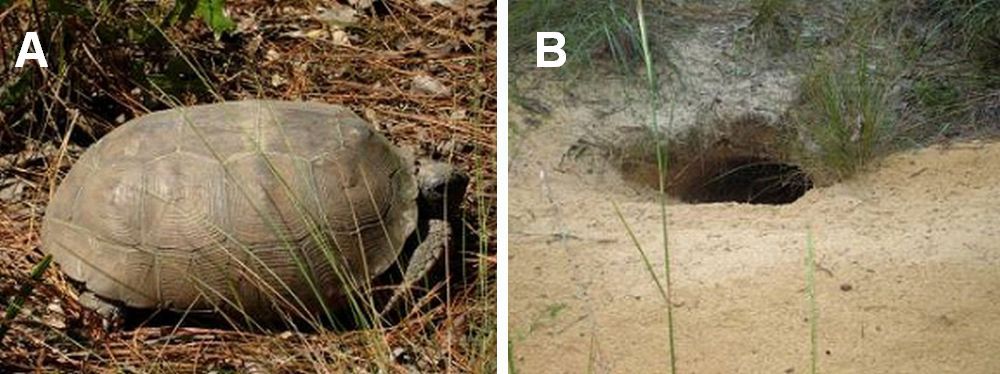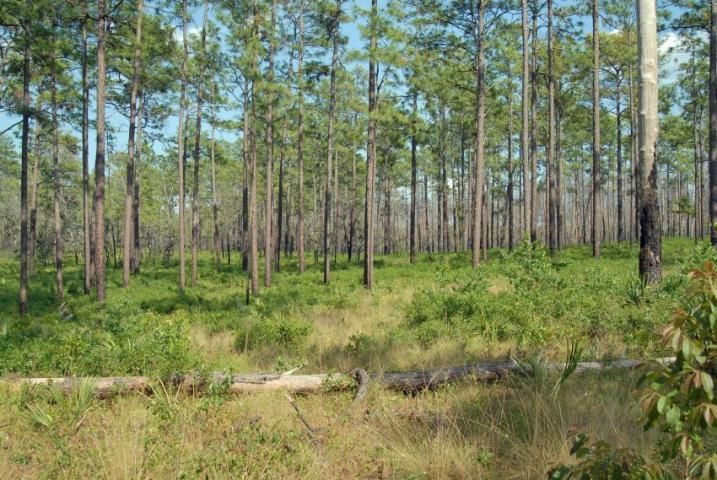Florida is home to ~30 species of native frogs and toads, which are found in a wide variety of habitats. The gopher frog (Rana capito; Figure 1) is found in xeric (dry) habitats throughout the Southeastern Coastal Plain of the United States, particularly longleaf pine-wiregrass (Pinus palustris-Aristida beyrichiana) savannas. These large, plump frogs (2.5–3.5 in.) have wide heads and an obvious ridge down each side of the back, and their light-colored body is marked with dark brown or black blotches. Juvenile and adult gopher frogs spend most of their lives in upland terrestrial habitats, where they take shelter in burrows. Adults generally only return to wetlands in the late fall, winter, and early spring to breed and lay eggs; tadpoles develop in these wetlands, metamorphose into small versions of the adult, and disperse into terrestrial uplands. Gopher frogs can move long distances through terrestrial habitat and have been found more than a mile away from breeding ponds. In Florida, habitat loss and degradation have caused gopher frog populations to decline, and this frog is considered imperiled by the State of Florida. Gopher frogs appear to be doing better in Florida's peninsula than they are in the state's panhandle.

Credit: Elizabeth A. Roznik, UF/IFAS
Gopher frog populations face many challenges, and a major threat to the survival of this species is the disruption of natural fire cycles of the Southeastern Coastal Plain that historically maintained the habitat on which this species depends. Naturally occurring fires are now rare, and the aid of natural resource professionals who use prescribed fire to re-create the natural cycle is important for the survival of gopher frogs and other species adapted to fire-dependent habitats. Understanding the relationships between fire, burrowing animals, and the animals that use burrows helps land stewards to manage habitat more appropriately for these species.
The Benefits of Burrows to Gopher Frogs
Gopher frogs rely on burrows and other underground refuges for shelter. Of the 350 or more species of animals that are known to take shelter in the burrows of gopher tortoises (Gopherus polyphemus; Figure 2), the gopher frog is one of the most frequent burrow inhabitants. Gopher frogs also use the burrows of crayfish and small mammals, such as the southeastern pocket gopher, Geomys pinetis (for more information, read Ecological Engineers: Pocket Gophers are one of Nature's Architects https://edis.ifas.ufl.edu/UW285). Stump holes, spaces left by decaying roots of dead trees, are also important for shelter.

Credit: Elizabeth A. Roznik, UF/IFAS
These underground refuges provide many important benefits to gopher frogs. All amphibians have semi-permeable skin that can dry out quickly—if they are unable to find shelter from adverse weather conditions or reabsorb moisture from rain or wetlands, they may die. Desiccation (drying) is a major threat to gopher frogs because they live in hot, dry areas. Gopher tortoise burrows maintain fairly constant temperatures and high humidity throughout the year. The more stable, hospitable environment of tortoise burrows and other underground refuges provides protection from dry conditions and extreme warm and cold temperatures. Burrows also provide shelter from the periodic fires that are essential for maintaining both the terrestrial and wetland habitats gopher frogs require.
In addition to sheltering gopher frogs from extreme weather conditions, burrows also protect them from many predators, such as snakes, raccoons, and owls. Many mammal and bird predators do not enter burrows; instead, they prey on gopher frogs when they leave the protection of the burrow. Snake predators typically forage for prey by "smelling" their surroundings and following the scent of their prey. Although some snakes seek shelter in burrows, a snake at the entrance of a burrow may not detect a frog that is deep inside, and may not enter a burrow just to look for a meal. During the day, when gopher frogs are not active, burrows provide a safe place to rest. On warm nights, gopher frogs may leave the burrow to forage for prey, but they remain near the entrance of the burrow and quickly jump into the burrow if they feel threatened.
Although both juvenile and adult gopher frogs use burrows, these refuges are particularly important to juveniles. Small frogs lose moisture more quickly than adults and are also more susceptible to predation. The transition from aquatic to terrestrial habitat is a period of high mortality for juvenile gopher frogs, not only because of their vulnerability to desiccation and predation, but also because they are unfamiliar with their new terrestrial habitat and the locations of burrows. We attached tiny radio transmitters to newly metamorphosed gopher frogs in the Ocala National Forest and tracked them into the terrestrial habitat to learn how they deal with these challenges during the transition from wetland to upland. We found that burrows are essential to the survival of these young frogs. Only 12.5% of newly metamorphosed gopher frogs survived their first month in terrestrial habitat, and the majority of the frogs that did not survive were preyed upon by snakes. However, juvenile gopher frogs that were able to locate a burrow within a few days of exiting the pond, and did not change locations, were more protected from snake predators and often were able to survive to the end of our study.
The Role of Fire in the Longleaf Pine Ecosystem
In the longleaf pine ecosystem, fire is the driving force that affects all other components of the ecosystem, both directly and indirectly. Longleaf pine-wiregrass savannas were historically maintained by fires naturally ignited by lightning or intentionally set by Native Americans. These fires occurred frequently (1–3 year intervals), preventing hardwood trees such as oaks (Quercus spp.) from becoming dominant, and thereby maintaining an open, sunny habitat dominated by pines and grasses (Figure 3). When the intervals between fires are longer, or when fire is excluded altogether, hardwoods begin to invade, filling the open gaps among the pines (Figure 4). Soon, other fire-adapted plant species begin to decline as a result of increased shade. Over time, the habitat gradually transforms into a dense, shady, mixed pine-hardwood forest. Decades of fire suppression have contributed to the decline of the longleaf pine ecosystem throughout its range. The distribution of this ecosystem has been reduced by as much as 98%, and much of the longleaf pine-wiregrass habitat that remains is in poor condition. As a result of this habitat loss and degradation, many wildlife species associated with longleaf pine savannas have also declined, including the gopher frog and gopher tortoise.

Credit: Elizabeth A. Roznik, UF/IFAS

Credit: Elizabeth A. Roznik, UF/IFAS
The Importance of Fire to Gopher Frogs
Fire also impacts the animals in the longleaf pine-wiregrass ecosystem. Fire influences forest characteristics, such as the openness of the canopy and thickness of the underbrush, which influence the distribution of burrowing animals. In turn, the distribution of burrowing mammals affects the availability of shelter sites that are critical for gopher frog survival. When longleaf pine savannas burn frequently, they are dominated by longleaf pines, grasses, and herbaceous (non-woody) plants. This forest structure provides high-quality habitat that can support large populations of burrowing animals like gopher tortoises and small mammals, resulting in higher density of burrows and therefore more potential refuges for gopher frogs. Because natural fires no longer occur at a scale and frequency sufficient for maintenance of longleaf pine savannas, land managers must use prescribed fire to mimic the natural fire regime.
Like the gopher tortoises and burrowing mammals associated with longleaf pine savannas, gopher frogs also prefer regularly burned habitat over habitat that has been fire suppressed. By attaching radio-transmitters to juvenile and adult gopher frogs at ponds and tracking them into the terrestrial habitat, we found that both life stages chose fire-maintained habitat and avoided fire-suppressed areas with fewer potential shelter sites. Since survival of newly metamorphosed gopher frogs seems to depend on the ability of frogs to quickly locate burrows after exiting ponds (see "The Benefits of Burrows to Gopher Frogs" above), the ability of young frogs to identify and move into fire-maintained areas with higher densities of burrows should increase the probability that they will find a burrow and survive. Given the already low survival rate of juveniles, frequent fire is critical—higher juvenile survival means that more juveniles will mature and enter the breeding population as adults.
In addition to maintaining suitable terrestrial habitat for gopher frogs, fire also plays an important role in maintaining breeding ponds (Figure 4). Gopher frogs breed in temporary and semi-permanent ponds, which periodically dry out during drought years. Historically, fires that occurred during such dry periods would enter dry ponds from the surrounding terrestrial habitat, eliminating peat and vegetation encroaching on the pond basin. These occasional fires maintained the structural characteristics of the pond basin and also kept the forest canopy open around the pond. Today, land managers are encouraged to burn through dry ponds when conducting prescribed burns in order to mimic the behavior of natural fires. When breeding ponds become shaded as a result of fire suppression, wetland vegetation that provides shelter and food for tadpoles is often reduced, and water quality may be reduced. As a result, growth and survival of gopher frog tadpoles may be reduced, contributing to declines in local gopher frog populations or even local extinctions.
Other Gopher Frog Conservation and Management Concerns
In addition to the changes to their habitats as a result of fire suppression, gopher frogs face many other threats, both in terrestrial and aquatic habitats, and their conservation status is a concern in each state in which they occur. The greatest threat, aside from fire suppression, is habitat loss and alteration. Gopher frogs move long distances from breeding ponds and thus need large areas of habitat that are protected from urban development and conversion to other land uses, such as agriculture and tree farming, and actively managed with frequent prescribed fire. Factors that result in declines of gopher tortoises and burrowing mammals (e.g., disease) can also affect gopher frog populations by altering the availability of critical shelter sites. In areas where trees are harvested, the practice of removing stumps can also reduce availability of shelter sites by eliminating stump holes. Recreational ATV traffic can result in mortality of gopher frogs, even on forest roads, and the destruction of their subterranean burrows. Recreational ATV traffic through wetlands also destroys vegetation critical for egg-laying and tadpole food and shelter, and can have serious, long-term impacts on breeding habitat. In addition, gopher frogs breed in ponds that are fish-free because they dry out periodically, so the introduction of fish (e.g., for sport fishing) that prey on gopher frog eggs and tadpoles can also harm gopher frog populations. In order to protect species such as the gopher frog, land stewards must carefully consider the potential impacts of all land use practices.
Suggested Reading and References
W. B. Blihovde. (2006). Terrestrial movements and upland habitat use of gopher frogs in central Florida. Southeastern Naturalist 5:265–76.
P. Carmichael and Williams W. (1991). Florida's Fabulous Reptiles and Amphibians. California: World Publications.
R. Conant and Collins J. T. (1998). Peterson Field Guide: A Field Guide to Reptiles and Amphibians of Eastern and Central North America. 3rd expanded ed. Boston, MA: Houghton Mifflin.
C. H. Greenberg. (2001). Spatio-temporal dynamics of pond use and recruitment in Florida gopher frogs (Rana capito aesopus). Journal of Herpetology 35:74–85.
J. B. Jensen, Camp C. D., Gibbons J. W., and Elliott M. J., eds. (1998). Amphibians and Reptiles of Georgia. Athens, GA: University of Georgia Press.
J. B. Jensen and Richter S. C. (2005). Rana capito, gopher frog. In Amphibian Declines: the Conservation Status of United States Species, ed. M. Lannoo. (pp. 536–38) Berkeley, CA: University of California Press.
S.C. Richter, Young J. E., Seigel R. A., and Johnson G. N. (2001). Post-breeding movements of the dark gopher frog, Rana sevosa Goin and Netting: implications for conservation and management. Journal of Herpetology 35:316–321.
E. A. Roznik. (2007). Terrestrial ecology of juvenile and adult gopher frogs (Rana capito). M.S. Thesis, Gainesville, FL: University of Florida.
E. A. Roznik and Johnson S. A. (2009). Canopy closure and emigration by juvenile gopher frogs. Journal of Wildlife Management, 260–268.
E. A. Roznik and Johnson S. A. Burrow use and survival of newly metamorphosed gopher frogs (Rana capito). Journal of Herpetology (In press).
N. Y. Thurgate and Pechmann J. H. K. (2007). Canopy closure, competition, and the endangered dusky gopher frog. Journal of Wildlife Management 71: 1845–1852.